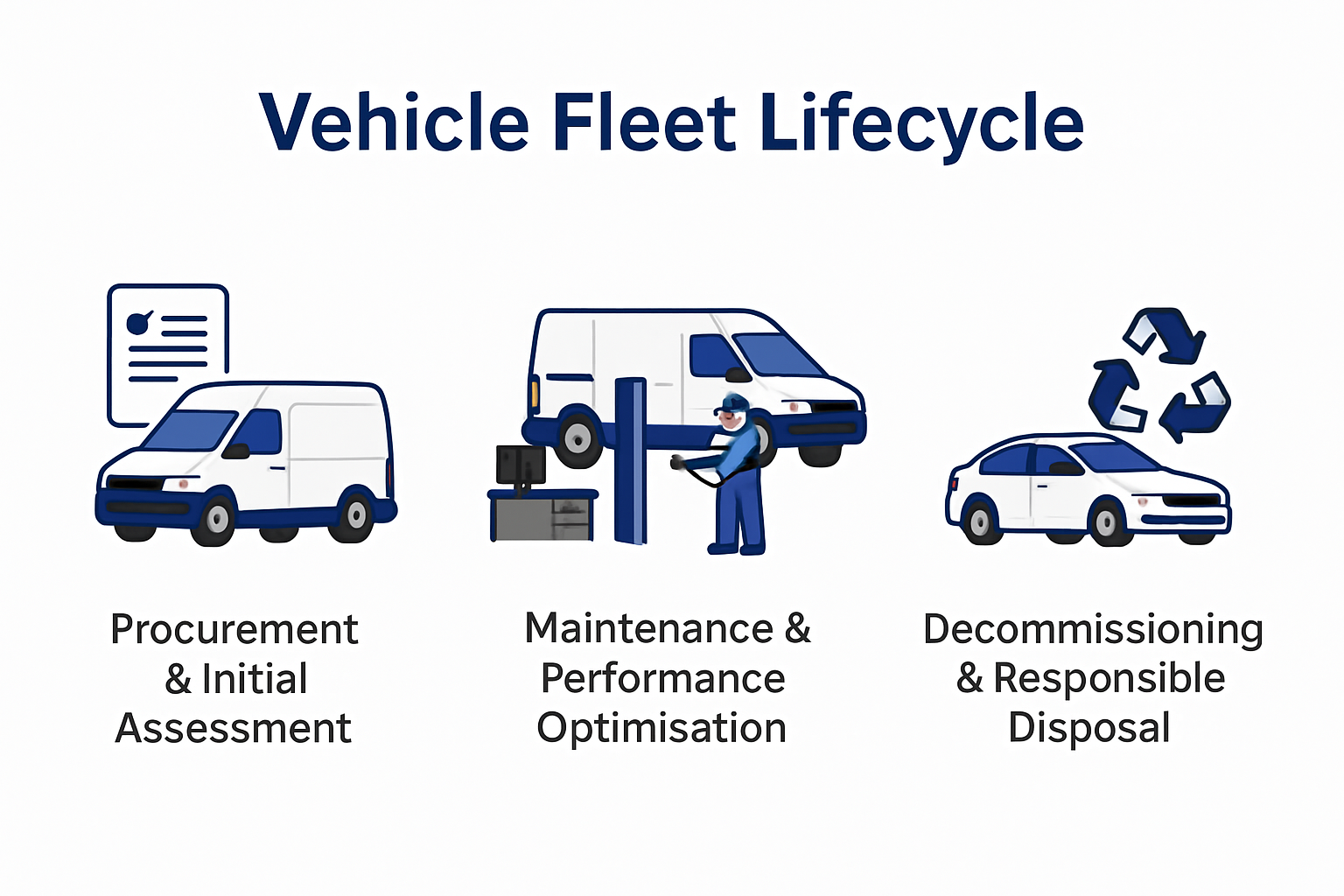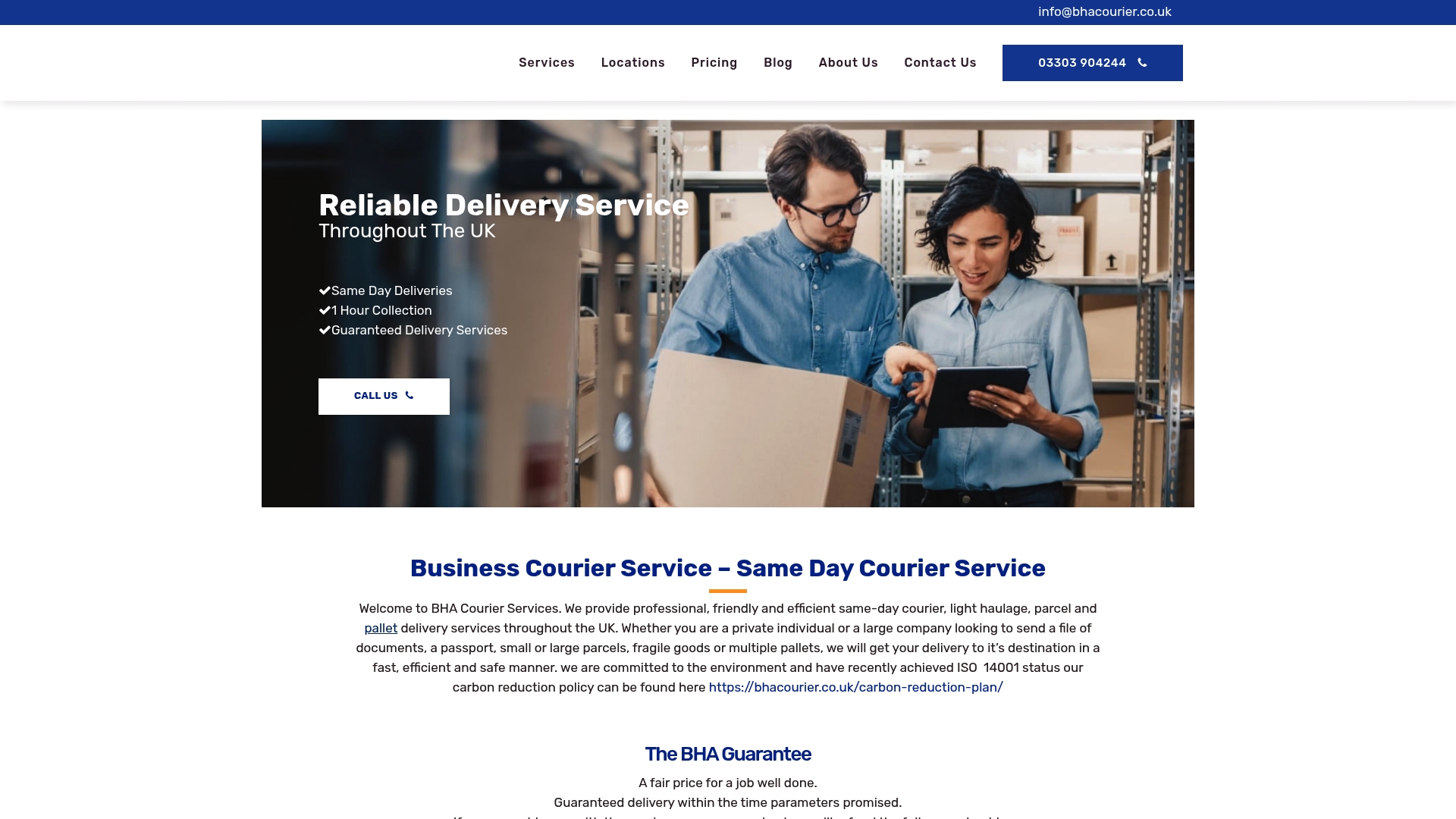
14 Aug Fleet Lifecycle Management: Boost Efficiency for UK Businesses
Managing a fleet has become more complicated than ever for UK businesses, with evolving tech and rising operational costs tightening the pressure. Yet, get this. Fuel now accounts for up to 30 percent of a typical fleet’s running expenses, which sends shockwaves through any company’s budget. Most surprising of all, the biggest cost savings rarely come from cutting trips or cheaper vehicles. Instead, they are unlocked through clever data tracking, smarter maintenance schedules and choosing the right moment to retire and replace each vehicle.
Table of Contents
- Understanding Fleet Lifecycle Management Basics
- Key Stages In The Vehicle Fleet Lifecycle
- Cost-Saving Strategies For Fleet Owners
- Best Practices For UK SME And Delivery Fleets
Quick Summary
| Takeaway | Explanation |
|---|---|
| Implement a strategic procurement process | Assess vehicle needs and total cost of ownership for effective purchases. |
| Prioritise maintenance and performance tracking | Regular checks and data analysis ensure vehicles operate efficiently and cost-effectively. |
| Adopt fuel efficiency measures | Optimise routes and train drivers to reduce fuel expenses significantly. |
| Embrace technology for fleet management | Use telematics and data analytics for real-time insights and predictive maintenance. |
| Plan for sustainable vehicle disposal | Ensure responsible decommissioning that complies with regulations and optimises financial returns. |
Understanding Fleet Lifecycle Management Basics
Fleet lifecycle management represents a comprehensive strategic approach for businesses to optimise their vehicle assets from acquisition through retirement. This systematic process ensures organisations maximise operational efficiency, control costs, and maintain a competitive edge in today’s dynamic business environment.
Core Components of Fleet Management
At its foundation, fleet lifecycle management encompasses several critical stages that guide vehicles from initial procurement to eventual disposal. Our guide on logistics management provides deeper insights into these strategic processes.
The U.S. Department of Energy’s Federal Energy Management Program highlights four essential principles that underpin effective fleet management. These include right-sizing vehicle fleets to match organisational needs, reducing overall vehicle miles traveled, improving fleet fuel efficiency, and strategically implementing alternative fuel technologies.
Strategic Vehicle Performance Tracking
Successful fleet lifecycle management demands continuous monitoring and data-driven decision making. According to research from the National Renewable Energy Laboratory, businesses must implement robust vehicle allocation methodologies that consider multiple performance metrics.
Key performance indicators businesses should track include:
- Maintenance Costs: Regular analysis of repair and servicing expenses
- Fuel Consumption: Monitoring fuel efficiency and exploring alternative energy options
- Depreciation Rates: Understanding vehicle value reduction over time
- Operational Downtime: Measuring periods when vehicles are unavailable for use
Economic and Environmental Considerations
Modern fleet lifecycle management extends beyond mere operational efficiency. The Washington State Department of Enterprise Services emphasises the importance of developing strategic vehicle-replacement cycles that balance economic prudence with environmental responsibility.
Businesses must consider multiple factors during each vehicle’s lifecycle, including depreciation, maintenance requirements, fuel consumption patterns, and potential resale value. This holistic approach ensures organisations can minimise long-term costs while maintaining a sustainable and adaptable fleet.
By implementing a comprehensive fleet lifecycle management strategy, UK businesses can achieve significant operational improvements, reduce unnecessary expenditures, and position themselves as forward-thinking enterprises in an increasingly competitive marketplace.
Key Stages in the Vehicle Fleet Lifecycle
A vehicle fleet lifecycle represents a strategic journey from initial acquisition to final disposal, encompassing multiple critical stages that demand meticulous planning and management. Our insights on emerging logistics trends provide further context into these evolving operational strategies.

Procurement and Initial Assessment
The first stage of fleet lifecycle management begins with strategic procurement. According to the Transportation Research Board, effective fleet management requires comprehensive evaluation of vehicle requirements, considering factors such as operational needs, budget constraints, and long-term performance potential.
Key considerations during procurement include:
- Vehicle Specifications: Matching vehicle capabilities to specific business requirements
- Total Cost of Ownership: Analyzing initial purchase price alongside projected maintenance and operational expenses
- Technological Compatibility: Ensuring vehicles integrate with existing operational systems
- Performance Metrics: Evaluating fuel efficiency, reliability, and potential environmental impact
Maintenance and Performance Optimization
Once acquired, vehicles enter a critical maintenance phase that directly influences their operational longevity and cost-effectiveness. The U.S. Department of Energy’s Federal Energy Management Program emphasises four core maintenance management functions: systematic inspection, preventive maintenance, corrective interventions, and robust management information systems.
Effective maintenance strategies involve:
- Regular Diagnostic Checks: Identifying potential mechanical issues before they escalate
- Scheduled Servicing: Implementing manufacturer-recommended maintenance protocols
- Performance Tracking: Monitoring vehicle efficiency, fuel consumption, and operational reliability
- Technological Updates: Integrating modern diagnostic and monitoring technologies
Decommissioning and Responsible Disposal
The final stage of fleet lifecycle management focuses on strategic vehicle retirement and disposal. According to the Logistics Operational Guide, responsible decommissioning involves multiple considerations beyond simple asset removal.
Comprehensive disposal strategies include:
- Valuation Assessment: Determining residual vehicle value
- Sustainable Disposal Methods: Exploring options like sale, donation, or responsible recycling
- Environmental Compliance: Ensuring disposal processes meet regulatory standards
- Financial Optimization: Maximizing potential returns from vehicle assets
By understanding and implementing these key stages, UK businesses can transform fleet lifecycle management from a routine operational task into a strategic advantage, reducing costs, improving efficiency, and maintaining a competitive edge in an increasingly dynamic business environment.
To help visualise the core functions and outcomes during fleet lifecycle management, the following table summarises the key stages along with their main objectives and example actions:
| Stage | Main Objective | Example Actions |
|---|---|---|
| Procurement & Initial Assessment | Acquire right vehicles at best value | Assess needs, analyse TCO, check compatibility |
| Maintenance & Performance Optimisation | Maximise uptime and cost-effectiveness | Scheduled servicing, diagnostic checks |
| Decommissioning & Disposal | Responsible retirement and value recovery | Value assessment, sustainable disposal |
Cost-Saving Strategies for Fleet Owners
Effective cost management represents a critical challenge for fleet owners seeking to optimise operational efficiency and financial performance. Our guide on green logistics strategies offers additional insights into sustainable approaches that can simultaneously reduce expenses and environmental impact.
Fuel Efficiency and Consumption Optimization
Fuel expenditure typically constitutes one of the most significant ongoing costs for fleet operations. According to the U.S. Government Accountability Office, implementing strategic fuel efficiency measures can deliver substantial economic benefits for businesses.
Key strategies for reducing fuel-related expenses include:
- Route Optimization: Utilizing advanced GPS and mapping technologies to minimise unnecessary mileage
- Driver Training: Implementing programs focused on fuel-efficient driving techniques
- Vehicle Selection: Choosing models with superior fuel consumption ratings
- Regular Maintenance: Ensuring vehicles operate at peak mechanical efficiency
Vehicle Rightsizing and Fleet Rationalization
Fleet owners can achieve significant cost reductions by critically evaluating their vehicle inventory and eliminating unnecessary assets. This approach involves systematically assessing each vehicle’s utilization, operational requirements, and total cost of ownership.
Comprehensive fleet rationalization strategies encompass:
- Utilization Tracking: Monitoring individual vehicle usage rates and identifying underperforming assets
- Performance Benchmarking: Comparing vehicle performance against industry standards
- Age and Replacement Analysis: Developing strategic vehicle replacement protocols
- Flexible Fleet Composition: Maintaining adaptable vehicle configurations that match evolving business needs
Technology and Data-Driven Cost Management
Modern fleet management increasingly relies on sophisticated technological solutions to drive cost efficiency. Advanced telematics, predictive maintenance systems, and comprehensive data analytics provide fleet owners unprecedented insights into operational performance.
Technological approaches to cost reduction include:
- Predictive Maintenance: Utilizing sensor data to anticipate and prevent potential mechanical failures
- Real-Time Performance Monitoring: Tracking vehicle metrics to identify efficiency opportunities
- Automated Reporting: Generating detailed cost analysis and performance benchmarks
- Integration of Management Systems: Connecting fleet operations with broader business intelligence platforms
By implementing these strategic approaches, UK businesses can transform fleet management from a traditional cost centre into a dynamic mechanism for financial optimization. Proactive investment in efficiency, technology, and systematic evaluation enables organizations to reduce expenses, improve operational performance, and maintain a competitive edge in an increasingly complex business environment.
Below is a comparison table outlining common cost-saving strategies for fleet owners, their primary focus, and key example measures, making it easier to evaluate which approaches might benefit your business:
| Strategy Type | Primary Focus | Example Measures |
|---|---|---|
| Fuel Efficiency Optimisation | Reduce fuel costs | Route planning, driver training |
| Fleet Rightsizing | Eliminate excess costs | Utilisation tracking, flexible composition |
| Technology Use | Enhance cost control | Telematics, predictive maintenance |
Best Practices for UK SME and Delivery Fleets
Small and medium-sized enterprises (SMEs) in the UK delivery sector face unique challenges in managing their vehicle fleets efficiently. Our comprehensive guide on delivery performance metrics provides additional insights into optimising operational effectiveness.
Strategic Fleet Planning and Acquisition
Successful fleet management for SMEs begins with meticulous planning and strategic vehicle acquisition. According to the National Academies of Sciences, Engineering, and Medicine, effective fleet lifecycle management requires a comprehensive approach that considers long-term operational needs and financial constraints.
Key strategic considerations include:
- Needs Assessment: Carefully evaluating specific business requirements
- Budget Alignment: Matching vehicle investments to financial capabilities
- Scalability: Selecting vehicles that can adapt to potential business growth
- Total Cost of Ownership: Analyzing long-term economic implications beyond initial purchase price
Technology and Operational Efficiency
Modern delivery fleets must leverage technological solutions to remain competitive and efficient. Small businesses can significantly improve their operational capabilities by implementing smart technological interventions that optimise route planning, vehicle tracking, and performance monitoring.
Critical technological strategies encompass:
- GPS Tracking Systems: Real-time vehicle location and route optimization
- Telematics Integration: Advanced performance monitoring and diagnostic capabilities
- Digital Fleet Management Platforms: Centralized systems for comprehensive operational control
- Automated Reporting: Generating insights for continuous improvement
Sustainability and Cost Management
UK SMEs are increasingly recognising the importance of sustainable fleet management as both an environmental and economic imperative. Modern delivery businesses must balance operational efficiency with responsible environmental practices.
Comprehensive sustainability approaches include:
- Fuel Efficiency Initiatives: Prioritising low-emission and electric vehicle options
- Maintenance Optimization: Implementing preventative maintenance strategies

- Carbon Footprint Reduction: Developing targeted strategies to minimise environmental impact
- Regulatory Compliance: Staying ahead of emerging environmental regulations
By adopting these best practices, UK SMEs and delivery fleets can transform their operational approach. Integrating strategic planning, technological innovation, and sustainable practices enables businesses to create more resilient, efficient, and competitive fleet management systems that drive long-term success in an increasingly complex business environment.
Frequently Asked Questions
What is fleet lifecycle management?
Fleet lifecycle management is a strategic approach that helps businesses optimise their vehicle assets from acquisition through to disposal. It ensures efficient operations, cost control, and competitiveness in the market.
How can businesses reduce fuel costs in fleet management?
Businesses can reduce fuel costs by implementing route optimisation, training drivers in fuel-efficient practices, selecting vehicles with better fuel consumption ratings, and ensuring regular vehicle maintenance.
What are the key stages in the vehicle fleet lifecycle?
The key stages in the vehicle fleet lifecycle include procurement and initial assessment, maintenance and performance optimisation, and decommissioning and responsible disposal of vehicles.
What technologies can improve fleet management efficiency?
Technologies such as telematics for real-time performance monitoring, GPS tracking systems for route optimisation, and predictive maintenance tools to prevent mechanical issues can significantly improve fleet management efficiency.
Take the Stress Out of Fleet Management and Keep Your Deliveries Moving
Managing costs and efficiency in your fleet can feel overwhelming, especially when handling urgent, high-value deliveries across the UK. The article highlighted how key challenges such as unpredictable fuel expenses, downtime, and vehicle maintenance can slow your business and hurt your bottom line. If you are looking for more control over your operations and peace of mind for time-critical deliveries, you are not alone.

Let BHA Courier help you achieve smoother, smarter fleet operations. From secure same-day courier solutions to rapid, reliable next-day deliveries, our expertise supports your journey toward optimised vehicle usage and lower costs. Thousands of UK businesses trust us to deliver important goods swiftly and safely, allowing them to focus on growth rather than logistics headaches.
Ready to experience seamless delivery and professional support every step of the way? Visit BHA Courier to arrange your priority collection or contact our team to see how our services can help power your fleet strategies today.
Recommended
- What Is Logistics Management? Guide for UK Businesses 2025 – BHA Couriers
- Green Logistics Strategies for UK Businesses in 2025 – BHA Couriers
- New Trends in Logistics: What UK Businesses Need to Know in 2025 – BHA Couriers
- Streamlining Supply Chain in the UK: Expert Tips for 2025 – BHA Couriers
- Top Benefits of Fleet Tracking for Businesses in 2025 | GPS Tracking Service – Dupno Tracker | Best Vehicle Tracking in Bangladesh %
- Fleet management software – – Bista Solutions

Sorry, the comment form is closed at this time.